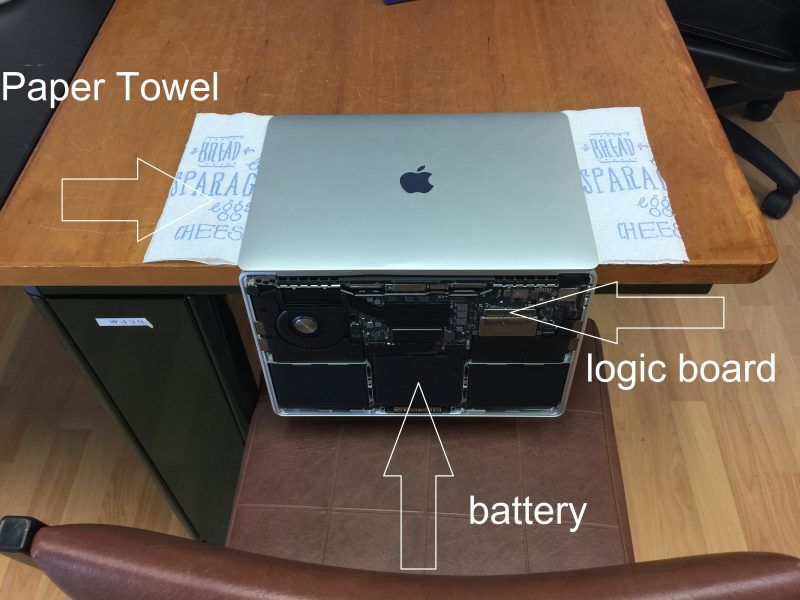If you’ve accidentally spilled water or another liquid on your MacBook, quick action is essential to avoid permanent damage. Here are some common questions and quick answers about draining liquid from a MacBook:
How do I know if there’s water inside my MacBook?
Signs of liquid inside your MacBook include seeing condensation under the screen, sticky keys, the trackpad not responding properly, or the computer not turning on at all.
What’s the first thing I should do if my MacBook gets wet?
Immediately unplug your MacBook and turn it off. Don’t try to turn it back on until you’ve drained it thoroughly.
How do I get the water out?
Turn your MacBook upside down to let gravity help drain the liquid. Gently shake it to dislodge any droplets trapped inside.
Assessing the Damage
Once you’ve drained as much liquid as possible from your MacBook, you’ll need to thoroughly assess the damage before attempting to turn it back on. Here’s what to look for:
Inspect for moisture
Use a flashlight to look for any remaining moisture or condensation inside ports, vents, under keys, around internal components, etc. Dry these areas thoroughly with compressed air before proceeding.
Check for corrosion
Examine the internal hardware for any signs of corrosion – discoloration, mineral buildup, etc. This can occur if the liquid was conductive, like soda. Corrosion may require replacement of affected components.
Test functionality
Try using an external keyboard, mouse, and monitor to test basic functionality before powering on your MacBook. This allows you to check for keyboard/trackpad issues.
Attempt to turn on
Finally, connect the power adapter and press the power button. If it won’t turn on, you’ll need to get it repaired.
Drying Out Your MacBook
If your MacBook got very wet, additional drying steps are required before it’s safe to use again. Here are some tips:
Let it air dry
Leave your MacBook powered off and open in a dry, well-ventilated area. Air circulation will help evaporate any residual moisture.
Use drying agents
Place your MacBook in a sealed container with drying agents, like silica gel packs. This will absorb humidity and moisture.
Try a fan
Use a fan directed at the open MacBook at low speed. Don’t get the fan too close to avoid condensation.
Do not use external heat
Avoid hairdryers, heat guns, or other sources of direct heat, which can damage internal components.
When to Get Professional Help
For major liquid damage, it’s best to get professional help to safely dry out and repair your MacBook. Consider professional assistance if:
- There are signs of severe water damage – corrosion, mineral deposits, residue
- The liquid was conductive or corrosive
- Your MacBook won’t turn on after drying efforts
- You opened up the case but are unsure how to properly reseal it
Mac repair specialists have tools such as ultrasonic cleaners to thoroughly dry internal components without damage. They can fully disassemble, clean, dry, and reassemble your MacBook properly.
Do-It-Yourself Deep Cleaning Tips
If you want to clean up and dry out your MacBook on your own without professional help, follow these tips:
Remove case
Use a plastic spudger tool to carefully pry off the bottom case. This will expose the internal parts for cleaning.
Disconnect battery
Unplug the battery connector before cleaning to avoid short circuits. Handle connectors gently.
Clean components
Use 90% isopropyl alcohol and cotton swabs to gently clean connectors, ports, logic boards, etc. Let dry thoroughly.
Dry out holes
Use a can of compressed air to dry out any crevices, holes, or vents, holding the can upright to avoid liquid discharge.
Absorb moisture
Place moisture-absorbing packs or uncooked rice inside the open MacBook overnight to help evaporate moisture.
Check for damage
Inspect components for corrosion before reassembling. Replace any parts that look overly worn or damaged.
Reassemble carefully
Refer to online visual guides for your model to properly reattach all connectors, replace adhesive strips, and re-seat the bottom case.
Preventing Future Liquid Damage
To avoid repeating this ordeal, be mindful of liquids around your MacBook and take these basic precautions:
- Don’t eat or drink near your computer.
- Keep water bottles, houseplants, and other liquids away from your workspace.
- Use a spill-proof lid for hot beverages.
- Keep your MacBook away from edges of tables.
- Avoid working outdoors when rain or spills are likely.
- Use a waterproof case or cover when accessing your MacBook near pools, beaches, etc.
- Keep drinks, vases, and other liquids far from nightstands or surfaces where you use your MacBook.
- Supervise young children using your MacBook around food or drink.
- Promptly dry hands before using your computer to avoid drip damage.
- Set drinks down carefully and check for condensation on glasses.
Taking preventative measures will help keep moisture away from your MacBook’s sensitive internal components in the future.
Conclusion
Liquid damage to your MacBook can be frightening and costly. But by quickly draining away moisture, thoroughly drying internal components, cleaning connectors, and checking for corrosion, you can maximize your chances of recovery. For major spills or deep internal damage, professional assistance may be your best bet for proper repairs. With vigilance and prompt action, even a serious liquid incident doesn’t have to mean the end for your MacBook.
| Liquid type | Level of risk | What to do |
|---|---|---|
| Water | Medium risk | Drain immediately, dry thoroughly, look for corrosion |
| Coffee, tea, juice | High risk | Drain quickly, disassemble to clean interior |
| Soda, alcohol, etc. | Very high risk | Drain right away, bring to professional for cleaning |

